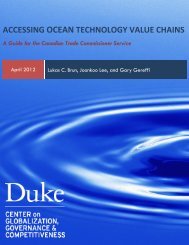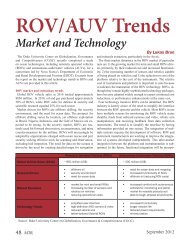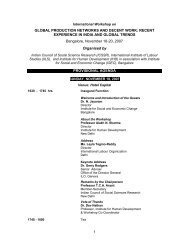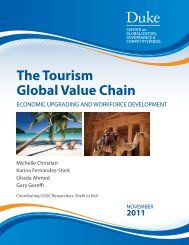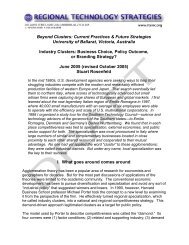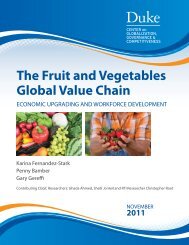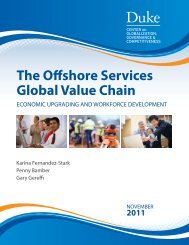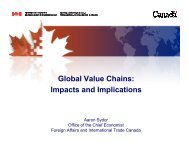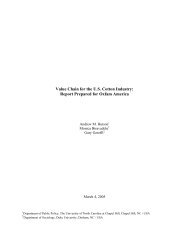Agricultural Value Chains in the Mexicali Valley of Mexico: Main ...
Agricultural Value Chains in the Mexicali Valley of Mexico: Main ...
Agricultural Value Chains in the Mexicali Valley of Mexico: Main ...
Create successful ePaper yourself
Turn your PDF publications into a flip-book with our unique Google optimized e-Paper software.
<strong>Agricultural</strong> <strong>Value</strong> <strong>Cha<strong>in</strong>s</strong> <strong>in</strong> <strong>the</strong> <strong>Mexicali</strong> <strong>Valley</strong> <strong>of</strong> <strong>Mexico</strong><br />
cha<strong>in</strong>, <strong>in</strong>vestigate <strong>the</strong> water-use pr<strong>of</strong>ile <strong>of</strong> <strong>the</strong> region’s crops, and who <strong>the</strong> important change-agents are for<br />
<strong>in</strong>creas<strong>in</strong>g <strong>the</strong> availability <strong>of</strong> water for <strong>the</strong> natural environment <strong>in</strong> <strong>the</strong> <strong>Mexicali</strong> <strong>Valley</strong>.<br />
Research Methods<br />
CGGC’s approach to value cha<strong>in</strong> studies is first to survey secondary source material for exist<strong>in</strong>g research on<br />
an <strong>in</strong>dustry, with <strong>the</strong> goal <strong>of</strong> develop<strong>in</strong>g background knowledge and identify<strong>in</strong>g important actors <strong>in</strong> <strong>the</strong><br />
production network <strong>of</strong> goods or services. Once <strong>the</strong> secondary source material has been reviewed, key actors<br />
identified through <strong>the</strong> <strong>in</strong>itial review process are contacted to answer follow-up questions about <strong>the</strong> <strong>in</strong>dustry.<br />
Key actors typically contacted <strong>in</strong> this second phase are academics who have written articles or reports about<br />
<strong>the</strong> topic; federal, state, and local governments who have written reports or convened meet<strong>in</strong>gs <strong>of</strong><br />
stakeholders on <strong>the</strong> topic <strong>of</strong> <strong>in</strong>terest; <strong>in</strong>dustry organizations; and perhaps most importantly, lead<strong>in</strong>g companies<br />
<strong>in</strong> <strong>the</strong> <strong>in</strong>dustry identified by o<strong>the</strong>rs as knowledgeable about <strong>the</strong> scope, conduct, and general dynamics <strong>of</strong> <strong>the</strong><br />
product market. Dur<strong>in</strong>g <strong>the</strong> <strong>in</strong>terviews, CGGC researchers ask respondents to name o<strong>the</strong>r actors with<strong>in</strong> <strong>the</strong><br />
<strong>in</strong>dustry, market segment, or value-cha<strong>in</strong> node, and ask for data or o<strong>the</strong>r written reports on <strong>the</strong> market. A<br />
draft value cha<strong>in</strong> based on <strong>the</strong>se first two phases <strong>of</strong> research is <strong>the</strong>n created. In <strong>the</strong> third phase <strong>of</strong> research,<br />
additional <strong>in</strong>terviews are scheduled with companies. The objective <strong>of</strong> this phase is to identify additional<br />
company names <strong>in</strong> <strong>the</strong> value cha<strong>in</strong> nodes, and to better understand <strong>the</strong>ir role <strong>in</strong> <strong>the</strong> production system. At this<br />
phase, company-level data on sales and employment are collected from multiple public and proprietary<br />
databases, <strong>the</strong> value cha<strong>in</strong> is revised, and a draft report is written. In <strong>the</strong> fourth phase <strong>of</strong> research, CGGC<br />
contacts <strong>in</strong>dividuals who are well-<strong>in</strong>formed about <strong>the</strong> <strong>in</strong>dustry and asks <strong>the</strong>m to review <strong>the</strong> value cha<strong>in</strong> and<br />
accompany<strong>in</strong>g report, and to provide comments and corrections <strong>of</strong> ei<strong>the</strong>r fact or <strong>in</strong>terpretation. Scholars at<br />
Duke and academic colleagues knowledgeable about <strong>the</strong> <strong>in</strong>dustry are contacted to conduct an <strong>in</strong>ternal review<br />
<strong>of</strong> <strong>the</strong> report, which is <strong>the</strong>n provided to <strong>the</strong> client for review. Revisions to <strong>the</strong> report as a result <strong>of</strong> <strong>the</strong> <strong>in</strong>ternal<br />
and external review process are made, <strong>the</strong> client is given <strong>the</strong> opportunity to give f<strong>in</strong>al approval <strong>of</strong> <strong>the</strong> report,<br />
and <strong>the</strong> report is published on <strong>the</strong> CGGC website (www.cggc.duke.edu). These research projects generally<br />
take between 3-6 months and hundreds <strong>of</strong> researcher hours to complete.<br />
Conduct<strong>in</strong>g value cha<strong>in</strong> studies <strong>in</strong> this manner is time <strong>in</strong>tensive, but provides a level <strong>of</strong> detail and<br />
understand<strong>in</strong>g <strong>of</strong> product markets not replicable by a review <strong>of</strong> only secondary source materials or a<br />
quantitative analysis <strong>of</strong> buyer-supplier relationships common <strong>in</strong> o<strong>the</strong>r <strong>in</strong>dustry analyses. In most develop<strong>in</strong>g<br />
world countries, for example, <strong>the</strong> data and classification systems necessary to conduct quantitative studies <strong>of</strong><br />
<strong>the</strong> <strong>in</strong>put-output structure <strong>of</strong> an <strong>in</strong>dustry simply is not available. Regardless <strong>of</strong> <strong>the</strong> availability <strong>of</strong> data,<br />
however, <strong>the</strong> more important po<strong>in</strong>t is that <strong>the</strong> bottom-up, ground level perspective <strong>of</strong>fers <strong>in</strong>sights <strong>in</strong>to markets<br />
that would be difficult to achieve us<strong>in</strong>g o<strong>the</strong>r methods. For example, while conduct<strong>in</strong>g this study on producers<br />
and buyers <strong>of</strong> agricultural products <strong>in</strong> <strong>the</strong> <strong>Mexicali</strong> <strong>Valley</strong>, CGGC researchers discovered <strong>the</strong> important role<br />
<strong>of</strong> <strong>in</strong>termediaries <strong>in</strong> <strong>the</strong> <strong>Mexicali</strong> <strong>Valley</strong> wheat market <strong>in</strong> aggregat<strong>in</strong>g supply from smaller growers, which is<br />
<strong>the</strong>n sold to large wholesale buyers who export to specific overseas markets. These <strong>in</strong>termediaries have<br />
market power that affect <strong>the</strong> way <strong>the</strong> entire value cha<strong>in</strong> for wheat functions. For <strong>the</strong> cotton market, we<br />
discovered that some <strong>of</strong> <strong>the</strong> large cotton producers <strong>in</strong> <strong>the</strong> region owned cotton g<strong>in</strong>s to supply domestic and<br />
overseas markets with processed cotton. Interviews with alfalfa producers quickly revealed that <strong>the</strong>ir<br />
production was largely <strong>in</strong>tended for cattle fodder for localized beef producers, while for vegetables, we<br />
discovered <strong>the</strong> importance <strong>of</strong> USDA regulations and <strong>the</strong> role <strong>of</strong> <strong>the</strong> 2003 Hepatitis A outbreak traced to<br />
green onions grown <strong>in</strong> <strong>Mexico</strong> to how <strong>the</strong> market conducts itself. We also discovered that water subsidies to<br />
<strong>the</strong> agricultural sector by <strong>the</strong> Mexican government play an important role <strong>in</strong> how water is used <strong>in</strong> <strong>the</strong> region<br />
Page 4



